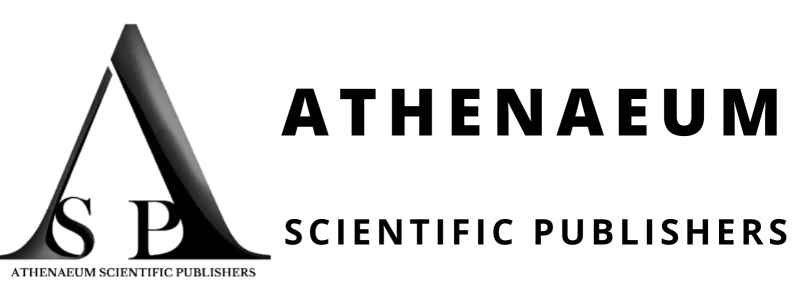Rinne M Peters1,2*, Louren M Goedhart1,3, Reinoud W Brouwer1
1Orthopaedic Surgery Department, Martini Hospital, Groningen, The Netherlands
2Orthopaedic Surgery Department, Medical Center Leeuwarden, Leeuwarden, The Netherlands
3Department of Orthopedic Surgery and Traumatology, Isala Hospital, Zwolle, The Netherlands
*Correspondence author: Rinne M Peters, MD PhD, Resident Orthopaedic Surgery, Orthopaedic Surgery Department, Martini Hospital Van Swietenplein 1, 9728 NT, Groningen, The Netherlands; Email: [email protected]
Published Date: 05-08-2024
Copyright© 2024 by Peters RM, et al. All rights reserved. This is an open access article distributed under the terms of the Creative Commons Attribution License, which permits unrestricted use, distribution, and reproduction in any medium, provided the original author and source are credited.
Abstract
Introduction: The prepatellar quadriceps continuation is an aponeurotic layer and arises downwards anteriorly over the patella originating from the rectus femoris tendon. A wide variance in thickness of the prepatellar quadriceps continuation has been described. This continuation could potentially remain intact following a patellar tendon rupture mimicking an intact patellar tendon during diagnostic ultrasonography.
Case presentation: We report a 43-year-old female patient with an injured knee after a direct blow during soccer. The patient was unable to actively extend her leg. After physical and conventional X-ray examination, a patellar tendon rupture was suspected. However, ultrasound demonstrated an elongated course of the patellar tendon without evidence of a rupture. An additional MRI scan revealed a complete patella tendon rupture with an intact overlying prepatellar quadriceps continuation as a normal variant.
Conclusion: A dysfunctional extensor mechanism and patella alta on conventional radiographs is pathognomonic for a ruptured patellar tendon. MRI is the preferred imaging method in case of discrepancy between the clinical presentation and ultrasound findings since there are normal variants of the extensor mechanism.
Keywords
Patella Tendon Rupture; Patella Tendon; Prepatellar Quadriceps Continuation
Case Report
Case Presentation
A 43-year-old female, without a significant medical history, visited the emergency department of a level 2 trauma hospital with an injured left knee. During a soccer match, she suffered a direct frontal blow on her left knee. Physical examination revealed mild effusion of the knee. Immediate pain was perceived when the patella was palpated. There was no palpable gap in the tendon. The patient was not able to actively extend her leg upon request. On the lateral radiograph, patella alta was observed along with a small bony avulsion suggestive for a patellar tendon rupture (Fig. 1). Based on clinical findings and conventional radiographs, a patellar tendon rupture was considered. An ultrasound evaluation revealed an elongated course of the patellar tendon without evidence of a rupture. There was no patellar fracture. The ossification at the level of the patellar tendon was considered old and post-traumatic. An extension splint was applied and the patient was sent home. Five days after the injury she visited the orthopaedic outpatient department. The patient was still not able to actively extent her knee or to raise the leg in extended position. An MRI scan was obtained. A high riding patella eg. patella alta was found on MRI along with a proximal patellar tendon rupture on the bursal side (Fig. 2). Furthermore, signs of proximal patellar tendinopathy with mild edema on the patellar apex were seen on the T2 sequence. Remarkably, the overlying prepatellar tendon aponeurotic layer seemed intact along with an intact extensor mechanism including the quadriceps tendon and muscles more proximally. On MRI, the patellar tendon was retracted approximately 2.5 centimetres. The decision for immediate surgical repair was made.
Operative Technique
After a median approach of the knee, the prepatellar quadriceps continuation was split to gain exposure of the underlying patella and patellar tendon. The patella tendon was ruptured from the apex of the patella (Fig. 3). A non-absorbable bony anker was placed in the apex of the patella (Fig. 3). Thereafter, the patella was distalized in extension and firmly re-attached to the patellar tendon. The overlying prepatellar quadriceps continuation was closed afterwards. The rehabilitation protocol allowed weight bearing in a long leg cast for 6 weeks. Afterwards, knee mobilisation and tendon strengthening was achieved with a physiotherapy regimen.
Postoperative Course
The postoperative radiograph showed a centrally placed non-absorbable bony anker in the distal portion of the patella (Fig. 4). Furthermore, approximation of the small bony fragment was observed towards the patellar apex on the lateral radiograph. Postoperative rehabilitation was uneventful. After 5 months of follow-up, the patient was doing fine with a knee flexion of 110 degrees and full active extension. She walks 5 kilometres on a daily basis.
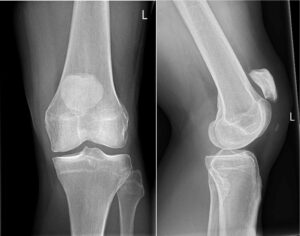
Figure 1: (A): Plain radiograph, anteroposterior; (B): On the right image, view of the left knee with a high riding patella e.g. patella alta, with an osseus fragment distal from the apex of the patella.
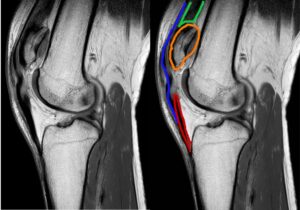
Figure 2: (A): Sagittal T1-weighted MRI image of the left knee demonstrating complete patellar tendon rupture with a small bony avulsion. An intact prepatellar quadriceps continuation is observed as a normal variant; (B): On the right image, the patella is marked in orange with the patellar tendon is marked in red. The prepatellar quadriceps continuation is marked in blue, with the quadriceps muscle marked in green.
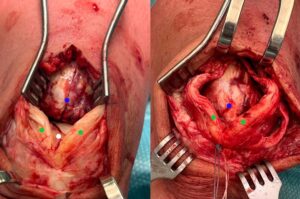
Figure 3: Intra-operative images of the knee. (A): After a median approach the prepatellar quadriceps continuation (marked in green) was split to gain exposure of the underlying patella (marked in blue) and patellar tendon (marked in white); (B): On the right image, A non-absorbable bony anker was placed in the apex of the patella, the patella was distalized in extension and firmly re-attached to the patellar tendon.
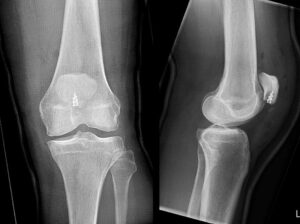
Figure 4: (A): AP and sagittal; (B): On the right image, postoperative radiograph of the knee with a centrally placed bony anker in the apex of the patella and a restored normal height of the patella.
Discussion
This case illustrates a rare case of a ruptured patella tendon in the presence of a prepatellar continuation of the quadriceps tendon. After initial misinterpretation of the ultrasound images due to this anatomical variant, the patellar tendon rupture was recognized on MRI and treated accordingly.
Extensor Mechanism Injuries
Injuries to the extensor complex of the knee are common and include quadriceps tendon rupture, patella fracture and patella tendon rupture [1]. Ruptures of the patella tendon are most typically encountered in male patients within their 3rd or 4th decade [2]. Patella tendon ruptures can occur due to a tensile force on the extensor mechanism or sudden quadriceps contraction, often with the knee in flexed position [2]. Infrapatellar pain, swelling, extensor lag with a high riding patella will be present in case of a complete tear. Local risk factors include patella tendinopathy, corticosteroid injections and previous injury. Diabetes, rheumatoid arthritis, SLE and renal pathology are known as associated systemic conditions [3].
Anatomy of the Patella Tendon and Normal Variants
The patellar tendon or patellar ligament is part of the extensor mechanism of the knee. The patellar tendon is a continuation of the quadriceps femoris tendon from the inferior pole of the patella to the tibial tuberosity [4]. The quadriceps tendon is a multi-layered and laminated structure in which four components (rectus femoris, and resp. vastus medialis, intermedius and lateralis) converge to form the quadriceps tendon [1]. The prepatellar quadriceps continuation is an aponeurotic layer and arises downwards anteriorly over the patella originating from the rectus femoris tendon. A cadaveric study showed a wide variance in thickness of the prepatellar quadriceps continuation ranging from 0.5 mm up to 7.8 mm [5]. Therefore, as in this case report, a thickened quadriceps continuation could potentially remain intact following a patellar tendon rupture.
In this specific case, the clinical diagnosis of a patellar tendon rupture was made after physical examination combined with the conventional radiographs. Upon availability, an ultrasound was performed in the emergency department. This caused a discrepancy since the prepatellar continuation was mistaken for an intact patella tendon.
This discrepancy initially altered the decision towards a conservative regimen. We believe that, when in doubt, an ultrasound could prove inconclusive due to the variable thickness of the prepatellar quadriceps continuation. Therefore, MRI should be the preferred imaging method if clinical symptoms of an dysfunctional extensor mechanism are not concordant with additional ultrasound findings.
Conclusion
We presented a unique case in which a thickened quadriceps continuation remained intact and concealed an underlying patellar tendon rupture. A dysfunctional extensor mechanism and patella alta on conventional radiographs is pathognomonic for a ruptured patellar tendon. Ultrasound examination might be inconclusive due to anatomical variants of the extensor mechanism and therefore additional MRI is indicated in case of a high index of clinical suspicion.
Clinical Message
The prepatellar quadriceps continuation is an aponeurotic layer and arises downwards anteriorly over the patella originating from the rectus femoris tendon. A wide variance in thickness of the prepatellar quadriceps continuation has been described. This continuation could potentially remain intact following a patellar tendon rupture mimicking an intact patellar tendon during diagnostic ultrasonography. Ultrasound examination might be inconclusive due to these anatomical variants of the extensor mechanism and therefore additional MRI is indicated in case of a high index of clinical suspicion.
Conflict of Interests
The authors declare that they have no known competing financial interests or personal relationships that could have appeared to influence the work reported in this paper.
Authors Contributions
Authors contributed to: (1) performing surgery, (2) initiating of case report, (3) initial draft, preparing images (4) and (5) final draft. R.M.P. contributed to: (2), (3), (4), (5), L.M.G. contributed to (1), (2), (3), (4), and (5), and R.W.B. contributed to (1), (2), (3), (5).
Sources of Funding
No benefits in any form have been received or will be received related directly or indirectly to the subject of this article. No funding was received in order to perform this study.
Ethics Approval / Institutional Review Board Statement
Not applicable
Statement of Informed Consent
The authors have obtained the patient’s written informed consent for print and electronic publication of this study.
Data Availability
The data used to support the findings of this study are available from the corresponding author upon request.
References
- Majeed H, dos Remedios I, Datta P, Griffiths D. Prepatellar continuation rupture: Report of an unusual case. Knee 2014;21(5);979-81.
- Pengas IP, Assiotis A, Khan W, Spalding T. Adult native knee extensor mechanism ruptures. Injury. 2016;47(10):2065-70.
- Rose PS, Frassica FJ. Atraumatic bilateral patellar tendon rupture, A case report and review of the literature. J Bone Joint Surg Am. 2001;83(9):1382-6.
- Bennett K, Vincent T, Sakthi-Velavan S. The patellar ligament: A comprehensive review. Clin Anat. 2022;35(1):52-64.
- Wangwinyuvirat M, Dirim B, Pastore D, Pretterklieber M, Frank A, Haghighi P, et al. Prepatellar quadriceps continuation: MRI of cadavers with gross anatomic and histologic correlation. AJR Am J Roentgenol. 2009;192(3):W111-6.
Article Type
Case Report
Publication History
Accepted Date: 16-07-2024
Accepted Date: 29-07-2024
Published Date: 05-08-2024
Copyright© 2024 by Peters RM, et al. All rights reserved. This is an open access article distributed under the terms of the Creative Commons Attribution License, which permits unrestricted use, distribution, and reproduction in any medium, provided the original author and source are credited.
Citation: Peters RM, et al. Patellar Tendon Rupture with Intact Overlying Prepatellar Quadriceps Continuation: A Case Report. J Ortho Sci Res. 2024;5(2):1-6.

Figure 1: (A): Plain radiograph, anteroposterior; (B): On the right image, view of the left knee with a high riding patella e.g. patella alta, with an osseus fragment distal from the apex of the patella.

Figure 2: (A): Sagittal T1-weighted MRI image of the left knee demonstrating complete patellar tendon rupture with a small bony avulsion. An intact prepatellar quadriceps continuation is observed as a normal variant; (B): On the right image, the patella is marked in orange with the patellar tendon is marked in red. The prepatellar quadriceps continuation is marked in blue, with the quadriceps muscle marked in green.

Figure 3: Intra-operative images of the knee. (A): After a median approach the prepatellar quadriceps continuation (marked in green) was split to gain exposure of the underlying patella (marked in blue) and patellar tendon (marked in white); (B): On the right image, A non-absorbable bony anker was placed in the apex of the patella, the patella was distalized in extension and firmly re-attached to the patellar tendon.

Figure 4: (A): AP and sagittal; (B): On the right image, postoperative radiograph of the knee with a centrally placed bony anker in the apex of the patella and a restored normal height of the patella.
